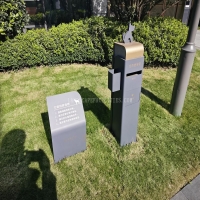Welcome to the website for landscape facilities products and knowledge.
How does the inclusion of a built-in paella pan or wok burner affect the design of a landscape bar counter?
The integration of specialized cooking elements like built-in paella pans or wok burners fundamentally reimagines the landscape bar counter from a passive serving area to an active culinary hub. This transformation impacts design across multiple dimensions—spatial planning, material selection, social dynamics, and aesthetic cohesion.
Structurally, these features demand robust support systems. A paella pan requires a custom-cut opening with heat-resistant insulation, typically using stainless steel or stone surrounds to contain high heat. Wok burners need powerful gas lines (often 25,000+ BTU) and deeper cavities to accommodate traditional rounded bottoms. This necessitates thicker countertops—minimum 2" stone or reinforced concrete—to handle the weight and thermal stress.
Ventilation becomes critical. Unlike standard BBQ islands, these intense cooking methods require integrated downdraft systems or overhead hoods discreetly incorporated into pergolas or ceiling structures. Designers often create tiered counters, placing cooking zones 4-6 inches lower than serving surfaces to conceal ventilation while maintaining sightlines.
The social architecture shifts dramatically. Circular or curved counters emerge to surround the cooking station, creating theatrical "chef's table" experiences. Materials transition from heat zones (using porcelain or granite) to cooler areas (wood or composite) within a single continuous surface. Storage solutions adapt to hold large pans and wok utensils, often with custom copper or stainless steel compartments that blend with outdoor aesthetics.
Functionally, the layout prioritizes workflow triangles. A typical configuration places the burner within arm's reach of prep sinks (with brass or bronze fixtures to resist corrosion) and insulated storage for ingredients. This creates a seamless cook-serve flow that keeps hosts engaged with guests rather than trapped in a separate kitchen.
Aesthetically, these elements become focal points. Hammered copper paella pans or blue flame wok burners add visual drama against stone countertops. Designers often use contrasting materials like dark slate around cooking zones to highlight the functionality while maintaining luxury appeal.
Ultimately, this integration elevates the landscape bar from a mere entertainment feature to a multifunctional culinary destination that blends authentic cooking capabilities with sophisticated outdoor living design.
Related search:

Recommendation
Outdoor cat and dog feces trash can; Community pet trash can; Metal multi-color design